Michael Drury
| Michael Drury | |
|---|---|
 Mint Street Baptist Church, Lincoln, 1870 | |
| Born |
28th July 1832 Lincoln. |
| Died |
6th February, 1890 Lincoln |
| Nationality | English |
| Alma mater | Pupil of William Adams Nicholson, |
| Occupation | Architect |
| Practice | In Lincoln from 1853 -c1885, later Drury and Mortimer. |
Michael Drury (1832 – after 1881) was an English architect working in Lincoln.
Life
Michael Drury was born about 1832 in Lincoln. He was apprenticed to the Lincoln architect William Adams Nicholson and appears to have continued his practice, working from No 1, Bank Street (on corner with Silver Street) in Lincoln.[1] He became Lincoln City Surveyor and 1868 was called upon by the City Council to give evidence about the state drains in the city, which were giving rise to much ill health.[2] Later in 1878 he was responsible for the new drainage and sewerage scheme for Lincoln and kept extensive notes on the many Roman discoveries that were made in the Bailgate and along the High Street in Lincoln.[3] In 1863 he was the Curator and sub-treasurer of the Lincolnshire Architectural and Archaeological Society. In 1881 he was living at Foss Lodge, Lincoln. Drury specialised in church restoration work. The architect Albert Vicars, who specialised in church architecture served his articles with Michael Drury. Around 1870 Drury joined William Mortimer in a partnership which lasted until about 1878. After this he worked by himself mainly laying out new streets and building terrace housing until 1889. [4]
Works
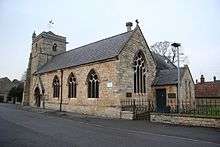
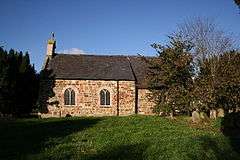

- Heighington Conversion of an earlier church building into a village school.
- The Anglican and Methodist /Dissenting Chapels at the Lincoln cemetery.
- Boultham Restoration of St Helens Church.
- Newton on Trent. Vicarage
- North HykehamLincs. Restoration of All Saints' church,North Hykeham, 1858 Neo-gothic in the 13th century style,
- Reepham, Lincolnshire|Reepham 1862
- Sotby.Lincolnshire Built a new nave to the church.
Drury and Mortimer
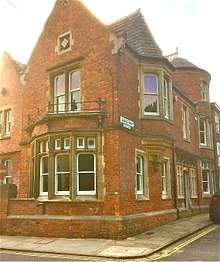
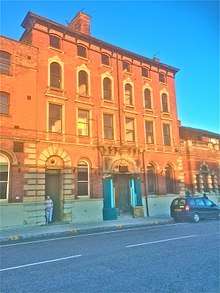
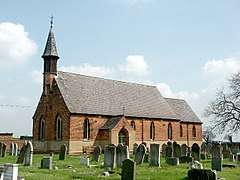
- The Albion Hotel,(1867), later the Barbican, St Mary's Street, Lincoln. Originally built as a Gentlemans' Club. Brick facade with two wings, ornate doorway, rustication and Venetian window to the clubroom which originally contained a Moorish smoking room.[5]
- [Mint St Baptist chapel.[Lincoln, England|Lincoln]] (1870) Now converted into the offices of Walters Estate agents, An example of Romanesque revival architecture in a debased Italianate Romanesque revival style in 1870.[6]
- 1 James Street, Lincoln (1874) Tudoresque with ornate doorway with decorative tiles. Built for Mrs Nicholson, the widow of the architect William Adams Nicholson.[7][8]
- The Mount, Spring Hill/Drury Lane, Lincoln. (1875) AVilla, set in the moat of Lincoln Castle.[9]
- St Luke's church.North Kyme Red brick church built in 1877
- Restoration of church.South Hykeham
References
- ↑ ”Brodie”,pg 564
- ↑ Sir Francis Hill (1974),Victorian Lincoln, Cambridge U.P., pg 167.
- ↑ Drury's notes on Roman discoveries are kept in Lincoln Central Library. See Jones M.J., (2002), Roman Lincoln: Conquest, Colony and Capital’', pp.14, 62 158 and figs. 2 & 32.
- ↑ Survey of Lincoln, Buildings Applications Database
- ↑ "Survey of Lincoln", Database of City Council Building Applications, Application nos. 11 & 12
- ↑ Antram N (revised), Pevsner N & Harris J, (1989), The Buildings of England: Lincolnshire, Yale University Press.pg 521-2.
- ↑ https://www.britishlistedbuildings.co.uk/101388607-1-james-street-lincoln#.WWlIo0vG79A
- ↑ "Survey of Lincoln", Database of City Council Building Applications, Application no.531.
- ↑ "Survey of Lincoln", Database of City Council Building Applications, Application no.657.
Literature
- Antram N (revised), Pevsner, N. & Harris J, (1989), The Buildings of England: Lincolnshire, Yale University Press.
- Antonia Brodie (ed), Directory of British Architects, 1834–1914: 2 Vols, British Architectural Library, Royal Institute of British Architects, 2001, Vol 2, pg. 565.
- Jones M (2011), Inexhaustable Themes for Study and Speculation,Michael Drury and the recording of Lincoln's buried archaeology, in Lincoln Connections:Aspects of City and County since 1700, Ed Brook S. et al, Society for Lincolnshire History and Archaeology. ISBN 9780903582421.
External Links
| Wikimedia Commons has media related to Michael Drury. |